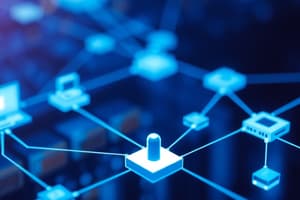Podcast
Questions and Answers
Describe the difference between physical network topology and logical network topology.
Describe the difference between physical network topology and logical network topology.
Physical topologies refer to the physical layout of devices and network media. Logical topologies refer to the logical paths in which data accesses the media and transmits packets across it.
What are the five types of physical topologies implemented in today's networks?
What are the five types of physical topologies implemented in today's networks?
Bus, Ring, Star, Extended star, Mesh.
What physical network topology connects all devices to one cable?
What physical network topology connects all devices to one cable?
Bus topology.
Describe a star and extended star physical topology.
Describe a star and extended star physical topology.
Describe a ring topology.
Describe a ring topology.
What physical network topology connects all devices to each other?
What physical network topology connects all devices to each other?
What is the difference between a mesh and a partial-mesh topology?
What is the difference between a mesh and a partial-mesh topology?
What is the logical topology of Ethernet?
What is the logical topology of Ethernet?
What do wireless networks use to communicate to end devices?
What do wireless networks use to communicate to end devices?
In wireless LANs (WLANs), what distributes the wireless signal?
In wireless LANs (WLANs), what distributes the wireless signal?
What are two types of Layer 1 network devices?
What are two types of Layer 1 network devices?
What are some network devices that operate at the data link layer (Layer 2)?
What are some network devices that operate at the data link layer (Layer 2)?
What is a LAN segment?
What is a LAN segment?
What are the Ethernet segment distance limitations for the following? - 100BASE-TX, 100BASE-FX, 1000BASE-T, 1000BASE-LX, 1000BASE-SX
What are the Ethernet segment distance limitations for the following? - 100BASE-TX, 100BASE-FX, 1000BASE-T, 1000BASE-LX, 1000BASE-SX
Flashcards are hidden until you start studying
Study Notes
Network Topology Fundamentals
- Physical Topology: Refers to the actual arrangement of devices and cables in a network.
- Logical Topology: Concerns how data flows over the network, including the paths through which packets travel.
Types of Physical Topologies
- Bus Topology: All devices connect to a single cable; only one device can transmit data at a time.
- Ring Topology: Devices are connected in a circular fashion; can be single-ring (one direction) or dual-ring (two directions for redundancy).
- Star Topology: Features a central hub/switch with all devices connected to it, resembling bicycle spokes; preferred for Ethernet networks.
- Extended Star Topology: An expansion of star topology with additional devices connected to main hub.
- Mesh Topology: Every device connects to every other device, providing fault tolerance and redundancy.
Differences in Topologies
- Mesh vs. Partial-Mesh: Full mesh connects all nodes to each other; partial mesh allows some nodes to connect to multiple devices only.
Ethernet Details
- Logical Topology of Ethernet: Operates on a logical bus topology, with physical implementations often being bus or star.
- Segment Distance Limitations:
- 100BASE-TX: 100 meters
- 100BASE-FX: 400 meters
- 1000BASE-T: 100 meters
- 1000BASE-LX: 550 meters (multimode), 10 km (single-mode)
- 1000BASE-SX: 250 meters (multimode), 550 meters (single-mode)
Wireless Networks
- Communication Methods: Wireless networks utilize radio frequency (RF) or infrared waves to connect devices.
- Signal Distribution: Access Points (AP) or wireless hubs distribute the wireless signal, received by nodes via wireless adapters.
Layer 1 Network Devices
- Repeaters: Amplify network signals to extend distance across media.
- Hubs: Multi-port repeaters that regenerate signals, differing from repeaters by having multiple connections.
Data Link Layer Devices
- Bridges and Switches: Operate at the data link layer, forwarding or filtering traffic based on MAC addresses. Bridges typically create LAN segments; switches are more advanced and replace hubs.
LAN Segment Definition
- LAN Segment: A single, continuous network connection made by unbroken cable, with limitations on distance due to signal degradation.
Studying That Suits You
Use AI to generate personalized quizzes and flashcards to suit your learning preferences.




